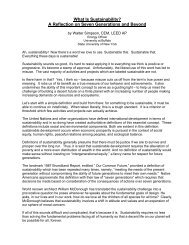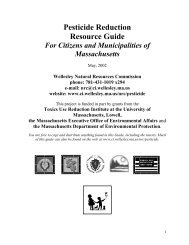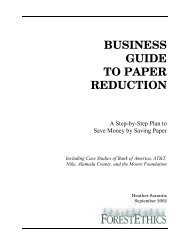Conference - Office of Sustainability - Tufts University
Conference - Office of Sustainability - Tufts University
Conference - Office of Sustainability - Tufts University
You also want an ePaper? Increase the reach of your titles
YUMPU automatically turns print PDFs into web optimized ePapers that Google loves.
touch, creating a link and awareness between people and their surrounding environments.<br />
Oberlin College is one <strong>of</strong> the many institutions <strong>of</strong> higher education utilizing their leverage<br />
power to enact change.<br />
Summary by: Jane Iwaki and Angela Ma<br />
PUBLICITY AND PUBLIC EDUCATION<br />
Chris Ball, Outreach Director, Ozone Action<br />
Jon Coifman, Associate Director, Environmental Media Services<br />
This seminar addressed a number <strong>of</strong> points important in getting people to take action for environmental<br />
issues. There are three things that anyone can do now to immediately take action<br />
on issues:<br />
• Write to your Congressional representative<br />
• Write letters to the editor which will educate readers on current issues<br />
• Vote your proxy in shareholder resolutions related to the environment<br />
More specifically, there are things you can do if you’re more dedicated or have the resources:<br />
• Organize briefing sessions with your representatives and the media to change<br />
misconceptions<br />
• Use paid advertising- include empowering messages that inform the public<br />
how they can get involved, along with a hotline number or address<br />
• Use similar issues that support your own in order to gain broader support<br />
• Get universities involved with campus-wide activism<br />
• Get the message to shareholders<br />
• Business outreach: try to get corporations involved to support the cause<br />
• Try to reach non-traditional constituencies<br />
The second group <strong>of</strong> suggestions takes more dedication but are important in getting the message<br />
across. Remember to use repetition so that the public, representatives, and media are well<br />
informed and understand the issues.<br />
Summarized by: Stephanie Kawachi<br />
HOW TO DO AN EMISSIONS INVENTORY<br />
Arden Ahnell, British Petroleum<br />
Ralph Torrie, Torrie Smith Associates<br />
Arden Ahnell provided an overview <strong>of</strong> the process and reasoning behind British Petroleum’s<br />
(BP) CO2 emissions inventory. Since the company’s management has made a bold commitment<br />
to reduce its CO2 emissions to 20% below 1990 levels by 2010, the emissions inventory<br />
was necessary to establish a baseline for future comparison. Mr. Ahnell explained that anoth-<br />
15







